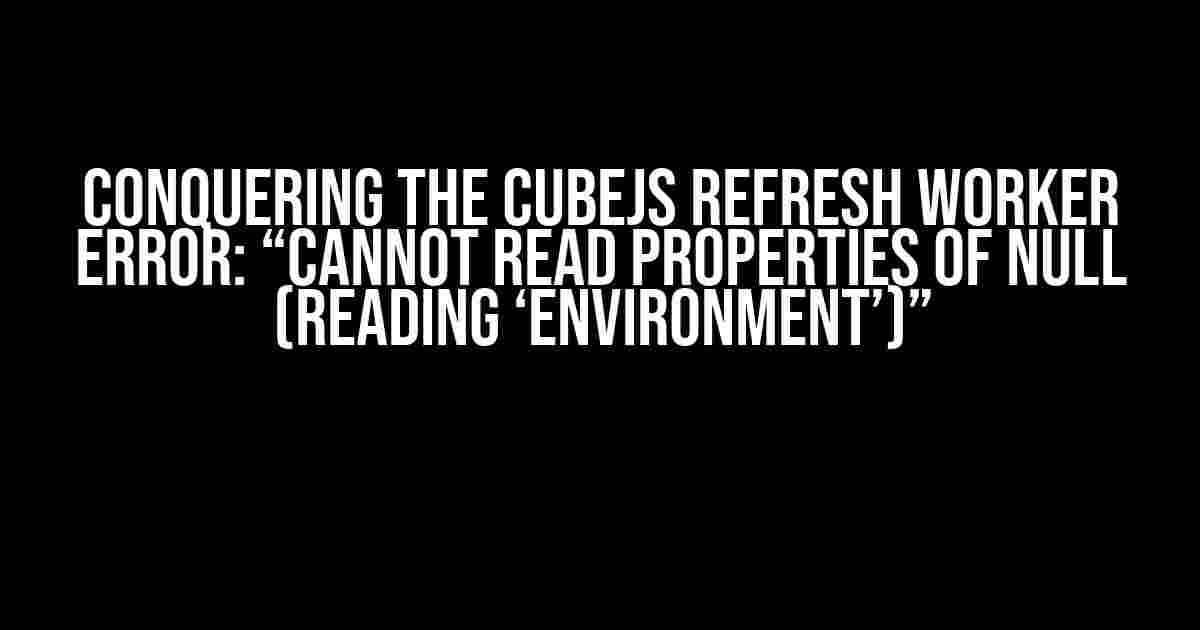Are you stuck with the frustrating CubeJS Refresh Worker Error that’s holding you back from extracting valuable insights from your data? Worry not, friend! You’re in the right place. In this comprehensive guide, we’ll delve into the root cause of the error, explore possible solutions, and provide step-by-step instructions to get your CubeJS instance up and running smoothly.
Understanding the Error: “Cannot read properties of null (reading ‘environment’)”
The error message “Cannot read properties of null (reading ‘environment’)” typically occurs when the CubeJS Refresh Worker is unable to access the environment variables required for its operation. This might be due to misconfigured environment settings, incorrect CubeJS setup, or a combination of both.
What is the CubeJS Refresh Worker?
The CubeJS Refresh Worker is a crucial component responsible for refreshing the data in your CubeJS instance. It’s a background process that runs periodically to ensure your data is up-to-date and reflects the latest changes. When the Refresh Worker encounters an issue, it can bring your entire analytics setup to a grinding halt.
Troubleshooting the Error: A Step-by-Step Guide
To resolve the “Cannot read properties of null (reading ‘environment’)” error, follow these troubleshooting steps:
Step 1: Verify Environment Variables
Check your environment variables to ensure they are correctly set. You can do this by running the following command in your terminal:
printenvThis command will display a list of all environment variables currently set. Look for the following variables:
- `CUBEJS_DB_HOST`
- `CUBEJS_DB_NAME`
- `CUBEJS_DB_PASSWORD`
- `CUBEJS_DB_USER`
- `CUBEJS_API_SECRET`
Make sure these variables are set and match the values in your `cube.js` file.
Step 2: Check CubeJS Configuration
Review your `cube.js` file to ensure it’s correctly configured. Pay attention to the following sections:
module.exports = {
// ...
refreshWorker: {
environment: {
// ...
}
}
};
Verify that the `environment` section is correctly defined and includes the necessary variables.
Step 3: Restart the Refresh Worker
After verifying your environment variables and CubeJS configuration, restart the Refresh Worker using the following command:
cubejs restartThis will restart the Refresh Worker and apply any changes you’ve made.
Step 4: Verify CubeJS Logs
Check the CubeJS logs to ensure the Refresh Worker is running smoothly. You can do this by running the following command:
cubejs logsLook for any error messages or warnings that might indicate the cause of the issue.
Common Causes of the Error
In addition to environment variable issues, there are several common causes of the “Cannot read properties of null (reading ‘environment’)” error:
Incorrect Environment Settings
If your environment variables are not set correctly, the Refresh Worker will fail to access the required settings, resulting in the error.
Misconfigured CubeJS Settings
Incorrect or missing CubeJS configuration settings can prevent the Refresh Worker from functioning properly.
Incompatible Dependencies
Outdated or incompatible dependencies can cause issues with the Refresh Worker. Ensure you’re running the latest versions of CubeJS and its dependencies.
Network Connectivity Issues
Network connectivity problems can prevent the Refresh Worker from accessing the required resources, leading to the error.
Best Practices for Avoiding the Error
To avoid encountering the “Cannot read properties of null (reading ‘environment’)” error, follow these best practices:
Use Environment Variables
Use environment variables to store sensitive information, such as database credentials, to ensure they’re not hardcoded in your CubeJS configuration.
Regularly Update Dependencies
Regularly update CubeJS and its dependencies to ensure you have the latest security patches and features.
Monitor CubeJS Logs
Regularly monitor CubeJS logs to detect any issues or warnings that might indicate a problem with the Refresh Worker.
Test Your CubeJS Instance
Regularly test your CubeJS instance to ensure it’s functioning correctly and identify any issues before they become critical.
Conclusion
In conclusion, the “Cannot read properties of null (reading ‘environment’)” error can be a frustrating obstacle, but by following the troubleshooting steps and best practices outlined in this guide, you should be able to resolve the issue and get your CubeJS instance up and running smoothly.
Remember to stay vigilant and monitor your CubeJS logs regularly to ensure the Refresh Worker is functioning correctly. With a little patience and persistence, you’ll be extracting valuable insights from your data in no time!
| Troubleshooting Step | Description |
|---|---|
| Verify Environment Variables | Check environment variables to ensure they are correctly set. |
| Check CubeJS Configuration | Review the `cube.js` file to ensure it’s correctly configured. |
| Restart the Refresh Worker | Restart the Refresh Worker to apply any changes. |
| Verify CubeJS Logs | Check the CubeJS logs to ensure the Refresh Worker is running smoothly. |
By following this comprehensive guide, you’ll be well-equipped to tackle the “Cannot read properties of null (reading ‘environment’)” error and get your CubeJS instance running smoothly. Happy analytics adventures!
Frequently Asked Question
Stuck with the “Cannot read properties of null (reading ‘environment’)” error in CubeJS Refresh Worker? Don’t worry, we’ve got you covered!
What causes the “Cannot read properties of null (reading ‘environment)” error in CubeJS Refresh Worker?
This error usually occurs when the `CUBEJS_API_SECRET` or `CUBEJS_API_TOKEN` environment variables are not set or are null. Make sure you have these variables set correctly in your CubeJS configuration file or as environment variables.
How do I set the `CUBEJS_API_SECRET` or `CUBEJS_API_TOKEN` environment variables?
You can set these environment variables in your `.env` file or as system environment variables. For example, in your `.env` file, add the following lines: `CUBEJS_API_SECRET=your_secret_key` and `CUBEJS_API_TOKEN=your_api_token`. Replace `your_secret_key` and `your_api_token` with your actual secret key and API token.
What if I’m using a CubeJS cloud deployment? How do I set the environment variables?
For CubeJS cloud deployments, you can set the environment variables in the CubeJS cloud dashboard. Go to the “Settings” tab, click on “Environment Variables”, and add the `CUBEJS_API_SECRET` and `CUBEJS_API_TOKEN` variables with their corresponding values.
Can I use a dotenv file to set the environment variables?
Yes, you can use a dotenv file to set the environment variables. CubeJS supports dotenv files, so you can create a `.env` file in the root of your project with the `CUBEJS_API_SECRET` and `CUBEJS_API_TOKEN` variables. CubeJS will automatically load the environment variables from the dotenv file.
What if I’m still getting the error after setting the environment variables?
If you’re still getting the error after setting the environment variables, try restarting your CubeJS server or checking the CubeJS logs for any other errors. Also, make sure you’re using the correct CubeJS version and that your configuration file is correct.



